I decided to travel to the east of Ukraine for the first time in my life – my purpose being to observe and talk to ordinary people, and to better understand how they live in frontline towns and cities.
One of the most beautiful is Kramatorsk in Donetsk region – a city under the Ukrainian flag, yet one which fell under Russian occupation for a three-month period in 2014. Following its de-occupation, the city was declared the regional center.
JOIN US ON TELEGRAM
Follow our coverage of the war on the @Kyivpost_official.
Before launching its unprovoked full-scale invasion of Ukraine in late February, Russia repeatedly shelled Kramatorsk. That shelling intensified from Feb. 24.
Locals tell me that if the explosions fall silent for two days, they become even more scared because “the silence itself is frightening.” One of the worst days for the city was on April 8, when an enemy rocket slammed into a railway station, killing more than 50 innocent people including five children.
Upon entering the city, a strange mirage of normality is evident. People walk through the streets and drink coffee, while the occasional bus trundles past. Later, there’s the wail of the air raid siren which, unlike in Kyiv, sounds for up to two minutes.
Only then do we notice that life is far from normal. Most business establishments in the city are closed, although some coffee shops open at their owners’ risk, in need of whatever money they can make. Today, four supermarkets are open in the city, but many of the shelves are bare. Prices have increased several times and many suppliers, beset by logistical challenges and surging fuel prices, refuse to transport products and goods to Kramatorsk. Of course, this situation is sadly not unique and is echoed across many front-line towns in Ukraine’s Donbas.

Trump Makes 90 Day Foreign Aid Freeze – Ukraine Military Support Supposedly Untouched
As we drive further through the city, we see the destruction of residential complexes and factories. According to Oleksiy Samisko, deputy head of the Kramatorsk district administration of the State Emergency Service, Russian attacks have pummeled industrial facilities, critical infrastructure and residential areas. Today, shells and rockets still fly seemingly without aim. A maternity hospital fell victim to one of the most recent attacks, and prior to that in early September, a psychiatric hospital.
Safer to go, but many want to stay
Samisko tells me that there are always new reports of injured people and some fatalities, but that the situation could be worse and the death toll much higher. According to Samisko, around two thirds of the city’s 180,000 pre-war inhabitants have evacuated, leaving 60,000 still in the city. But there is now the added complication of those trying to return.
“The larger the population in the city, the greater the number of potential victims. And we just don’t know what will happen next,” Samisko points out.
According to his sources, between 50 to 100 people on average are evacuated from the city every day. First, they are taken to nearby cities to board trains. Then they either they go to stay with people they know, or volunteers find them temporary shelters, such as in Kyiv or Lviv.
In addition to the threat of shelling, the city authorities have another reason to encourage people to leave – the heating season is approaching, and it will be very difficult indeed.
“If our armed forces don’t manage to push the enemy to a safe distance, the region will be without gas, because it will be impossible to restore the supply. So, it’s better to leave and spend the winter season in a safer area with heat and running water. Yes, there will be some inconveniences, but people will be warm and safe,” mayor of Kramatorsk Oleksandr Honcharenko explains.
During our journey through Kramatorsk, a fighter jet flies overhead. We immediately tense up but notice how others continue calmly about their daily business. We talk to local residents, who say that they are already used to this. And when we ask why they don’t leave, they simply say this:
“Where should I go? I’ve spent my whole life here. This is my home.”
I must have heard this same answer ten times.
Adaption
Later, we hear the boom and feel the thud of explosions. Some people head for their basements, but bomb shelters can be hard to find. Despite the war in Ukraine’s east now being in its ninth year, may of the city’s new buildings are still not well adapted to shelling.
“There are more cellars in the old town, because houses there were built after the Second World War. As Kramatorsk expanded over the years, no one thought that war would return here again. Still, people are prepared now – in fact they have been ready for eight years. Maybe that’s why they don’t want to go, because they’ve already experienced war,” says Samisko.
As day turns to dusk, the ebb and flow of people in the city streets fades away. The lights go out and the roads fall silent as the 9 p.m. curfew sets in. After all, the worst of the shelling happens at night. Residents lock themselves in their homes with the hope of going out once again as the new day dawns.
And so, life goes on. Kramatorsk, like many like it, is a Ukrainian city where the street lights no longer shine, save for the light of hope for Ukraine’s victory – and hope for the day when the sound of silence is once again part of everyday life rather than a moment to fear.
The views expressed are those of the author and not necessarily of Kyiv Post.
You can also highlight the text and press Ctrl + Enter










